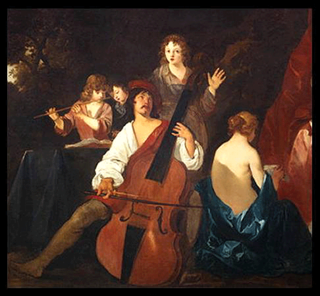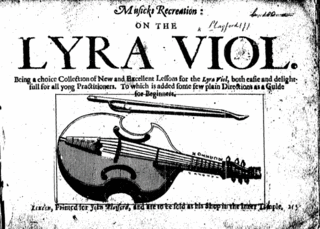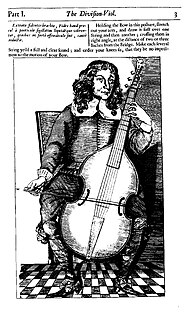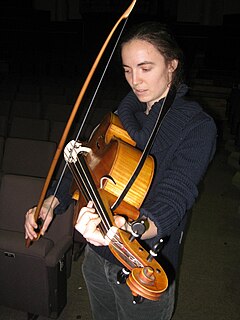
The term sackbut refers to the early forms of the trombone commonly used during the Renaissance and Baroque eras. A sackbut has the characteristic telescopic slide of a trombone, used to vary the length of the tube to change pitch, but is distinct from later trombones by its smaller, more cylindrically-proportioned bore, and its less-flared bell. Unlike the earlier slide trumpet from which it evolved, the sackbut possesses a U-shaped slide with two parallel sliding tubes, rather than just one.

The viol, viola da gamba, or informally gamba, is any one of a family of bowed, fretted, and stringed instruments with hollow wooden bodies and pegboxes where the tension on the strings can be increased or decreased to adjust the pitch of each of the strings. Frets on the viol are usually made of gut, tied on the fingerboard around the instrument's neck, to enable the performer to stop the strings more cleanly. Frets improve consistency of intonation and lend the stopped notes a tone that better matches the open strings. Viols first appeared in Spain in the mid-to-late 15th century, and were most popular in the Renaissance and Baroque (1600–1750) periods. Early ancestors include the Arabic rebab and the medieval European vielle, but later, more direct possible ancestors include the Venetian viole and the 15th- and 16th-century Spanish vihuela, a six-course plucked instrument tuned like a lute that looked like but was quite distinct from the four-course guitar.

Tobias Hume was a Scottish composer, viol player and soldier.

The viola organista is a musical instrument designed by Leonardo da Vinci. It uses a friction belt to vibrate individual strings, with the strings selected by pressing keys on a keyboard. Leonardo's design has intrigued instrument makers for more than 400 years, but though similar instruments have been built, no extant instrument constructed directly from Leonardo's incomplete designs is known. Sometimes it is mistakenly referred to as the harpsichord viola, which is a different instrument.

The lirone is the bass member of the lira family of instruments that was popular in the late 16th and early 17th centuries. It is a bowed string instrument with between 9 and 16 gut strings and a fretted neck. When played, it is held between the legs in the manner of a cello or viol.

The term violone can refer to several distinct large, bowed musical instruments which belong to either the viol or violin family. The violone is sometimes a fretted instrument, and may have six, five, four, or even only three strings. The violone is also not always a contrabass instrument. In modern parlance, one usually tries to clarify the 'type' of violone by adding a qualifier based on the tuning or on geography, or by using other terms that have a more precise connotation. The term violone may be used correctly to describe many different instruments, yet distinguishing among these types can be difficult, especially for those not familiar with the historical instruments of the viol and violin families and their respective variations in tuning.

Rauschpfeife is a commonly used term for a specific type of capped conical reed musical instrument of the woodwind family, used in Europe in the 16th and 17th centuries. In common with the crumhorn and cornamuse, it is a wooden double-reed instrument with the reed enclosed in a windcap. The player blows into a slot in the top of the windcap to produce the sound.
Alfonso Ferrabosco the younger was an English composer and viol player of Italian descent. He straddles the line between the Renaissance and Baroque eras.
Giacomo Vincenti was an Italian bookseller and music printer from Venice. He also spelled his name Vincenci and Vincenzi. He started printing in 1583. His partner was Ricciardo Amadino, and between 1583 and 1586 they printed about twenty books a year, mostly editions of music. Although their official partnership ended in 1586 they continued to use the same typefaces, collaborated on some editions, and held joint copyrights in others. In 1587, Vincenti published Luca Marenzio's Fourth Book of Madrigals, with the composer's dedication.

The lyra viol is a small bass viol, used primarily in England in the seventeenth century.

Philip Rosseter was an English composer and musician, as well as a theatrical manager. His family seems to have been from Somerset or Lincolnshire, he may have been employed with the Countess of Sussex by 1596, and he was living in London by 1598. In 1604 Rosseter was appointed a court lutenist for James I of England, a position he held until his death in 1623. Rosseter is best known for A Book of Ayres which was written with Thomas Campion and published in 1601. Some literary critics have held that Campion wrote the poems for Rosseter's songs; however, this seems not to be the case. It is likely that Campion was the author of the book's preface, which criticizes complex counterpoint and "intricate" harmonies that leave the words inaudible. The two men had a close professional and personal relationship; when Campion died in 1620, he had named Rosseter his sole heir.

The division viol is an English type of bass viol, which was originally popular in the mid-17th century, but is currently experiencing a renaissance of its own due to the movement for historically informed performance. John Playford mentions the division viol in his A Brief Introduction of 1667, describing it as smaller than a consort bass viol, but larger than a lyra viol.
Francesco Rognoni [of] Taeggio was an Italian composer. He was the son of Riccardo Rognoni and brother of Giovanni Domenico Rognoni Taeggio, both prominent Italian composers and musicians. He was active in Milan, but had connections with royalty from as far abroad as Archduke Charles of Austria, and King Sigismund III Vasa of Poland. Rognoni was a Papal Knight and hereditary Palatine Count. He published both collections of his works and treatises. His most famous work was Selva de varii passaggi, on both vocal and violin technique, and on how to ornament.
Chest of viols is a term which was used primarily in the 16th and 17th centuries in England for either a consort of viols, or the specialized cabinet made to contain a small consort of viols, usually containing six: two treble, two tenor, and two bass viols, or alternately two treble, three tenor, and one bass viol. According to Thomas Mace, "a good chest of viols" contained "six in number, 2 Basses, 2 Tenors, 2 Trebles, all truly proportionally suited."
Claudia Rusca was an Italian composer, singer, and organist.

The lira da braccio was a European bowed string instrument of the Renaissance. It was used by Italian poet-musicians in court in the 15th and 16th centuries to accompany their improvised recitations of lyric and narrative poetry. It is most closely related to the medieval fiddle, or vielle, and like the vielle had a leaf-shaped pegbox with frontal pegs. Fiddles with drone strings are seen beginning in the 9th century, and the instrument continued to develop through the 16th century. In many depictions of the instrument, it is being played by mythological characters, frequently members of angel consorts, and most often by Orpheus and Apollo. The lira da braccio was occasionally used in ensembles, particularly in the intermedi, and may have acted as a proto-continuo instrument.
Air à boire is a French term which was used between the mid-17th and mid-18th centuries for a "drinking song". These were generally strophic, syllabic songs to light texts. Its predecessor was chanson pour boire, the difference being mainly that chansons pour boire were for one voice with lute accompaniment, whereas airs à boire are generally for more than one voice.
In the years centering on 1600 in Europe, several distinct shifts emerged in ways of thinking about the purposes, writing and performance of music. Partly these changes were revolutionary, deliberately instigated by a group of intellectuals in Florence known as the Florentine Camerata, and partly they were evolutionary, in that precursors of the new Baroque style can be found far back in the Renaissance, and the changes merely built on extant forms and practices. The transitions emanated from the cultural centers of Northern Italy, then spread to Rome, France, Germany, and Spain, and lastly reached England . In terms of instrumental music, shifts in four discrete areas can be observed: idiomatic writing, texture, instrument use, and orchestration.

Baroque music refers to the period or dominant style of Western classical music composed from approximately 1600 to 1750. This era followed the Renaissance music era, and was followed in turn by the Classical era, with the galant style marking the transition between Baroque and Classical eras. The Baroque period is divided into three major phases: early, middle, and late. Overlapping in time, they are conventionally dated from 1580 to 1650, from 1630 to 1700, and from 1680 to 1750. Baroque music forms a major portion of the "classical music" canon, and is now widely studied, performed, and listened to. The term "baroque" comes from the Portuguese word barroco, meaning "misshapen pearl". The works of George Frideric Handel and Johann Sebastian Bach are considered the pinnacle of the Baroque period. Key composers of the Baroque era include, Claudio Monteverdi, Domenico Scarlatti, Alessandro Scarlatti, Antonio Vivaldi, Henry Purcell, Georg Philipp Telemann, Jean-Baptiste Lully, Jean-Philippe Rameau, Marc-Antoine Charpentier, Arcangelo Corelli, François Couperin, Heinrich Schütz, Dieterich Buxtehude, and others.

The violoncello da spalla, known informally as the cello da spalla, is a small cello played braced against the shoulder.













